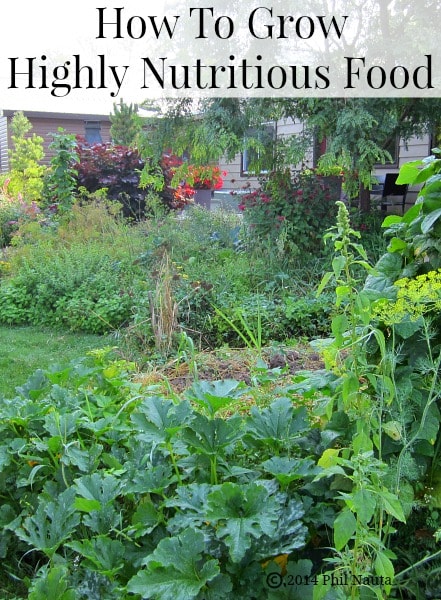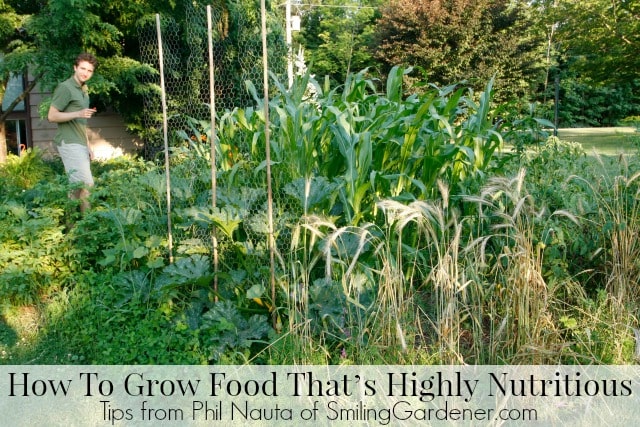Phil Nauta of SmilingGardener.com is sharing tips for how to grow food that’s highly nutritious and has fewer pests.
I’m a very frugal guy, but I’m also really into eating nutritious, organic food.
And that can be expensive.
So I grow my own food, partially to save money, and also because I’ve learned how to grow food that’s much more nutritious than food from the grocery store and even my local organic farmer’s market.
My name is Phil. I’m a certified organic gardener. I teach people how to grow nutritious organic food. Sometimes that involves bringing in some organic fertilizers, while sometimes you can make them yourself.
Today I’d like to share a few tips for how to most efficiently and affordably get more nutrition into the food you grow. These tips can be used whether you’re growing in a garden or containers or even in a jar.
By the way, the more nutrition your plants get, the healthier they’ll be, which means they won’t be bothered nearly as much by pests. Plus they’ll be much tastier and will keep fresh for a lot longer…
Homemade Fertilizer
Most nutrition for plants comes from the soil, and since our soils are often deficient in nutrients, we often need to bring some in. As much as possible, I like to do this by using local or homemade materials.
For example, you may have heard of using egg shells and banana peels in the garden, which is great, but probably won’t make much difference unless your garden is teeny tiny (or you have access to a whole lot of egg shells and banana peels).
But is there something we have more of that we could make use of? Yes, most of us have plenty of weeds and/or fresh grass clippings! Fill up a bucket with weeds and grass (and seaweed if you live near the beach) and then fill up the rest of the bucket with water. Cover with a lid and let sit for anywhere from a couple of weeks to a couple of months (the hotter the temperature, the shorter the process).
When the smell has largely died down, you can remove the plant material and use it as a mulch. What we’re really after is the liquid, which has now become a potent herbal tea. Mix it with at least 10 parts water and then use it to water your plants (and even spray it on your plants if you have some kind of sprayer) and they will be very happy (more details here)
Of course the other common organic input is compost. If you make a good quality aerobic compost or worm compost and add it to your soil, you’ll be bringing in not only nutrients, but beneficial organisms that play a huge role in the health of your garden. You don’t want to use too much compost because it can cause fertility imbalances in the soil that lead to some pretty major issues, but a little bit of good compost is a beautiful thing.
Purchased Fertilizer
Of course, some of us don’t have the time or materials to create a herbal tea or a compost pile. That’s when I recommend a few organic products that are affordable and very easy to use.
Even though I make my own herbal tea and compost, I use these products myself just to make sure the food I grow is as nutritious as possible. There are two main organic fertilizers I use:
- The first is a liquid seaweed from the ocean that’s loaded with minerals and especially known for the natural plant growth regulators and hormones it contains that help plants deal with stresses such as drought, extreme temperatures and disease.
- The second is a very concentrated sea minerals fertilizer from ocean water with most of the sodium chloride removed that has over 80 minerals in the perfect balance for plants. It gives our plants all of the micronutrients they need, which we in turn get when we eat them.
In addition to making sure our gardens have enough nutrients, it’s also important to make sure they have the beneficial microorganisms that actually feed plants and protect plants from predators.
That’s one of the main reasons to use good compost. The nutrients are great, but the beneficial bacteria and fungi are even better. But again, since most of us don’t have enough high quality compost around, there are a couple of products I’ve found to be very useful. They’re like probiotics for the garden:
- The first is called SCD Probiotics or Effective Microorganisms. It’s a liquid that can be sprayed or watered right onto plants to reestablish that beneficial biology that helps plants be healthy.
- The second is called mycorrhizal fungi. These special fungi form relationships with over 90% of plants in nature and are very important for the health of plants, but they are often deficient in our gardens because of tilling, past chemical use, etc.
If you’re just trying to grow a basic garden and aren’t too interested in growing nutrient-dense food, you don’t need to do all this stuff – a little bit of compost might be all you need. But if you’re after maximum nutrition and seem to have pests that just won’t go away, a few organic products can be very helpful. Thanks for reading 🙂
Phil Nauta is author of ‘Building Soils Naturally’ and teacher of organic gardening at SmilingGardener.com.



Leave a Reply